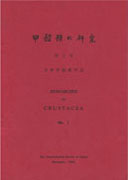Volume 6
Displaying 1-17 of 17 articles from this issue
- |<
- <
- 1
- >
- >|
-
Article type: Cover
1974 Volume 6 Pages Cover1-
Published: 1974
Released on J-STAGE: September 08, 2017
Download PDF (10K) -
Article type: Index
1974 Volume 6 Pages Toc1-
Published: 1974
Released on J-STAGE: September 08, 2017
Download PDF (56K) -
Article type: Appendix
1974 Volume 6 Pages App1-
Published: 1974
Released on J-STAGE: September 08, 2017
Download PDF (229K) -
Article type: Article
1974 Volume 6 Pages 1-16
Published: 1974
Released on J-STAGE: September 08, 2017
Download PDF (4272K) -
Article type: Article
1974 Volume 6 Pages 17-24
Published: 1974
Released on J-STAGE: September 08, 2017
Download PDF (1762K) -
Article type: Article
1974 Volume 6 Pages 25-30
Published: 1974
Released on J-STAGE: September 08, 2017
Download PDF (1552K) -
Article type: Article
1974 Volume 6 Pages 31-47
Published: 1974
Released on J-STAGE: September 08, 2017
Download PDF (5207K) -
Article type: Article
1974 Volume 6 Pages 48-51
Published: 1974
Released on J-STAGE: September 08, 2017
Download PDF (1154K) -
Article type: Article
1974 Volume 6 Pages 52-57
Published: 1974
Released on J-STAGE: September 08, 2017
Download PDF (1725K) -
Article type: Article
1974 Volume 6 Pages 58-70
Published: 1974
Released on J-STAGE: September 08, 2017
Download PDF (4123K) -
Article type: Article
1974 Volume 6 Pages 71-85
Published: 1974
Released on J-STAGE: September 08, 2017
Download PDF (4145K) -
Article type: Article
1974 Volume 6 Pages 86-102
Published: 1974
Released on J-STAGE: September 08, 2017
Download PDF (5509K) -
Article type: Article
1974 Volume 6 Pages 103-121
Published: 1974
Released on J-STAGE: September 08, 2017
Download PDF (6489K) -
Article type: Article
1974 Volume 6 Pages 122-135
Published: 1974
Released on J-STAGE: September 08, 2017
Download PDF (4685K) -
Article type: Article
1974 Volume 6 Pages 136-142
Published: 1974
Released on J-STAGE: September 08, 2017
Download PDF (1649K) -
Article type: Appendix
1974 Volume 6 Pages 143-144
Published: 1974
Released on J-STAGE: September 08, 2017
Download PDF (413K) -
Article type: Cover
1974 Volume 6 Pages Cover2-
Published: 1974
Released on J-STAGE: September 08, 2017
Download PDF (6K)
- |<
- <
- 1
- >
- >|
